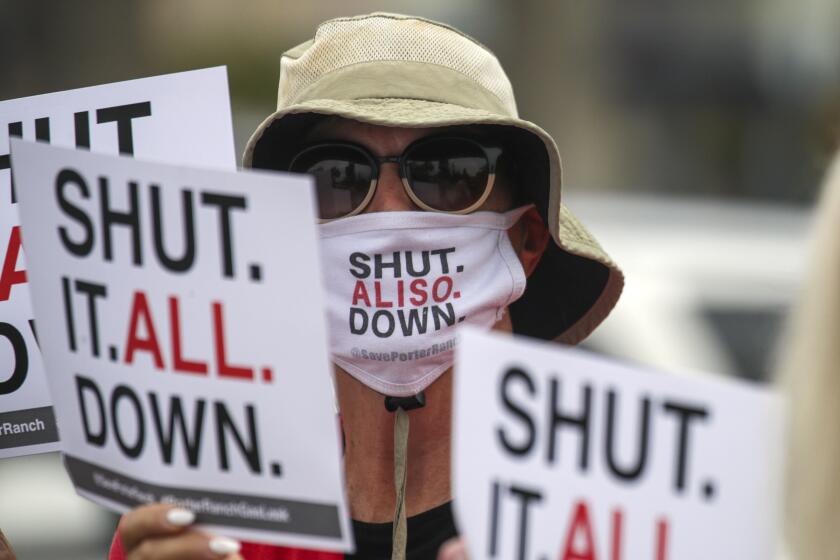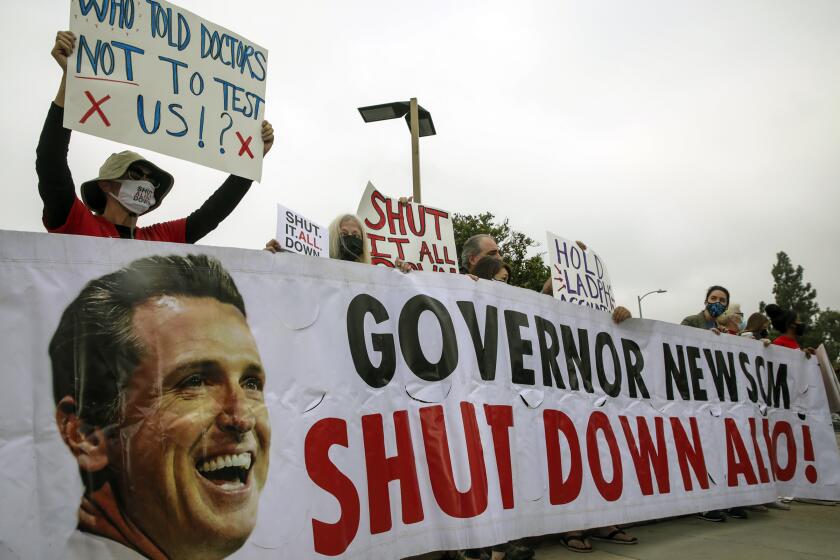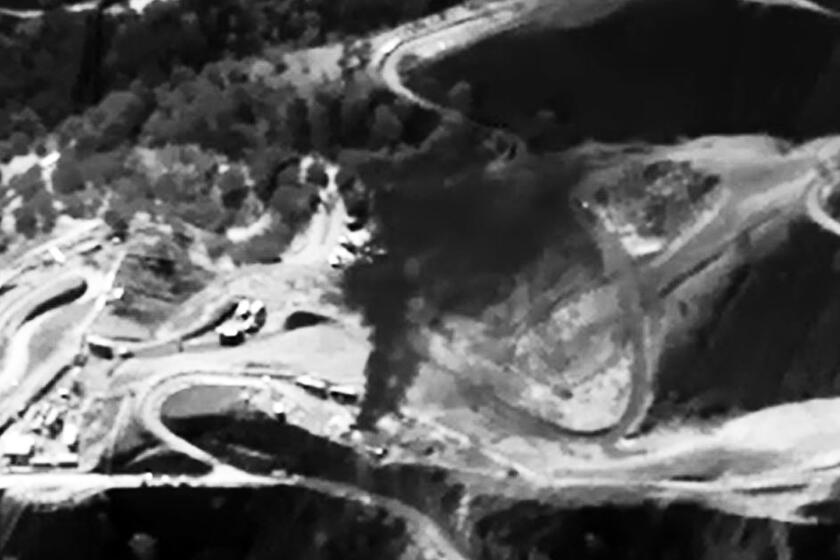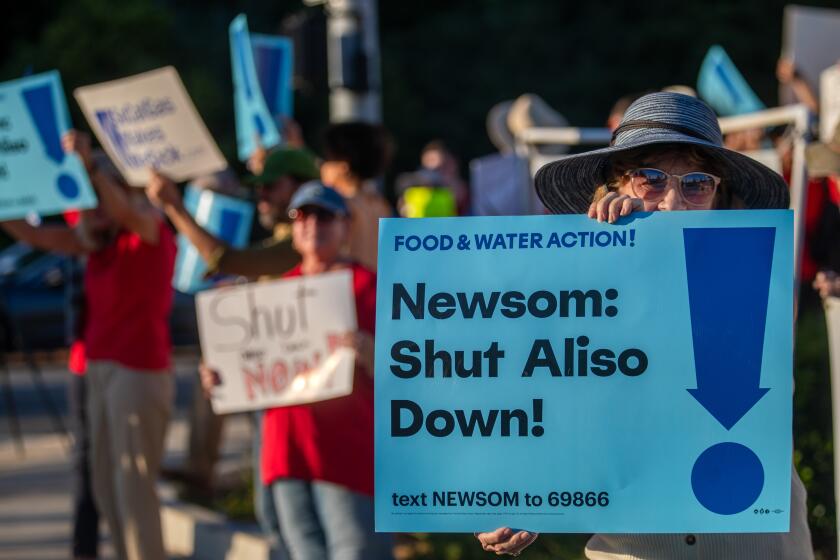California regulators propose plan that could close Aliso Canyon. Or is it just ‘kicking the can’?

- Share via
The California Public Utilities Commission this week unveiled a proposal that could potentially close the Aliso Canyon gas storage field in the coming years, but local activists and politicians say it doesn’t provide a fast or clear enough timeline to shut down the site of the largest natural gas leak in American history.
Residents in Porter Ranch and surrounding San Fernando Valley communities have been clamoring to close the Southern California Gas Co.-owned site ever since the leak took place over a four-month period in late 2015 and early 2016. The disaster spewed about 100,000 tons of methane and other chemicals into the air, forcing more than 8,000 families to flee their homes, with many reporting headaches, nosebleeds and nausea.
On Wednesday, the CPUC unveiled a proposed decision regarding the future of Aliso Canyon. The plan, which will be discussed at the commission’s Dec. 19 meeting, calls for moving ahead with potentially closing the site once Southern California’s demand for natural gas declines to a level at which peak demand can be served without Aliso Canyon.
Demand is expected to continue its downward trajectory in the coming years as California increases its utilization of renewable energy sources.
Residents of Porter Ranch and other nearby communities have waited more than six years for the study to commence.
The CPUC proposes initiating proceedings to review and potentially close the facility once the peak demand forecast for two years out decreases to 4,121 million metric cubic feet per day — and a biennial assessment shows that doing so would not jeopardize natural gas reliability or reasonable rates. Current peak demand forecast is 4,618 million metric cubic feet per day, and that is expected to drop to 4,197 million in 2030, according to a CPUC information sheet.
“We continue to review the decision but share the commission’s view that Aliso Canyon is a necessary part of California’s energy infrastructure today,” SoCalGas spokesperson Chris Gilbride said in a statement Friday.
Several politicians who represent Porter Ranch and support closing Aliso Canyon said they are frustrated by what they see as a lack of urgency and clarity around when the site will realistically cease operation.
“The optimism part is that there is a path to shut it down,” Assemblywoman Pilar Schiavo (D-Chatsworth) said in a phone interview. “The skeptical side, however, is there really is no timeline. It’s unclear.”
Southern California Gas will pay up to $1.8 billion to victims of a methane blowout. But the story isn’t over.
State Sen. Henry Stern (D-Calabasas) said he wants the CPUC to provide evidence for why a gradual timeline is in the public’s best interest.
“The burden is on the CPUC to prove to the public that this proposal to extend the life of Aliso Canyon is not just a give away to the SoCalGas Company at the expense of the community,” he said in a statement on X.
Los Angeles County Supervisor Lindsey Horvath called the draft decision “unacceptable” in a statement, and said it “fails to prioritize the health and wellbeing of a community that bore the brunt of the worst natural gas leak in American history.”
“My position is unchanged: We need a clear end date and plan for full closure,” she said.
Southern California Gas will pay up to $1.8 billion to victims of a methane blowout. But the story isn’t over.
This sentiment was echoed by Matt Pakucko, the president of the advocacy group Save Porter Ranch, which has fought to close the storage facility since shortly after the leak.
He said the commission was “kicking the can down the road” with its proposed biennial assessment process.
“They’re checking every two years instead of immediately closing down the facility as residents and our group have been asking for for years,” Pakucko said.
The company has a contentious relationship with the Porter Ranch community and, in the aftermath of the leak, faced a litany of lawsuits alleging it knew about issues at the site and failed to address the problems. Firefighters also filed suits alleging that the company failed to inform them about the extent of their exposure to harmful chemicals when responding to the leak.
Southern California Gas Co. agrees to an up to $1.8-billion settlement with victims of the 2015 Aliso Canyon gas leak.
In 2016, SoCalGas pleaded no contest to a misdemeanor count of failing to immediately report the gas leak and, in 2021, agreed to pay up to $1.8 billion to settle the claims of more than 35,000 victims.
Since then, the company has implemented a number of safety improvements at Aliso Canyon as part of various legal settlements and agreements with government agencies.
This includes installing an infrared methane monitoring system, having a state agency complete safety tests on all 114 wells, hiring employees to operate new leak-detection systems 24 hours a day, adopting new reporting policies for releases of hazardous materials and increasing employee safety training.
Pakucko said he places the blame for the gas facility’s continual use on Gov. Gavin Newsom.
“This isn’t an energy issue, it’s a health issue,” Pakucko said.
In 2019, Newsom called on the CPUC to look into accelerating the facility’s permanent shutdown. But in 2023, his appointees to the CPUC voted 5-0 in favor of allowing SoCalGas to store far more fuel at the site to help bring down gas rates.
Eight years after a record methane blowout, Gov. Gavin Newsom has yet to fulfill his pledge to shut down the gas field.
In a 2023 email, Newsom spokesperson Alex Stack said the governor “appreciates the [Public Utilities Commission’s] efforts to maintain affordable and reliable energy for ratepayers, and he continues to encourage the commission to expedite their work to permanently close the facility as part of California’s transition away from fossil fuels.”
Rising natural gas costs were a big issue last winter when SoCalGas said the average bill for its 21.8 million customers in January 2023 was about $300, more than twice the average of January 2022.
The company blamed unusually cold winter weather and constraints on pipelines and gas storage facilities for the spike in prices. Others blamed the company for mismanaging its inventory and increasing exports to Europe to take advantage of high prices due to the Russia-Ukraine war.
More to Read
Sign up for Essential California
The most important California stories and recommendations in your inbox every morning.
You may occasionally receive promotional content from the Los Angeles Times.
















